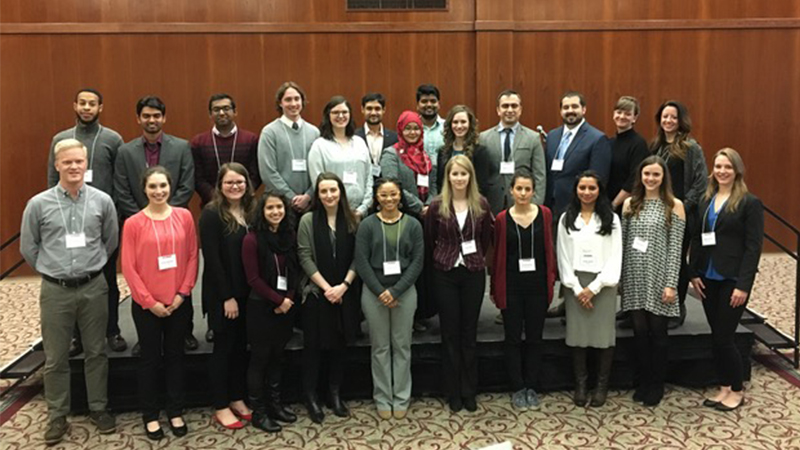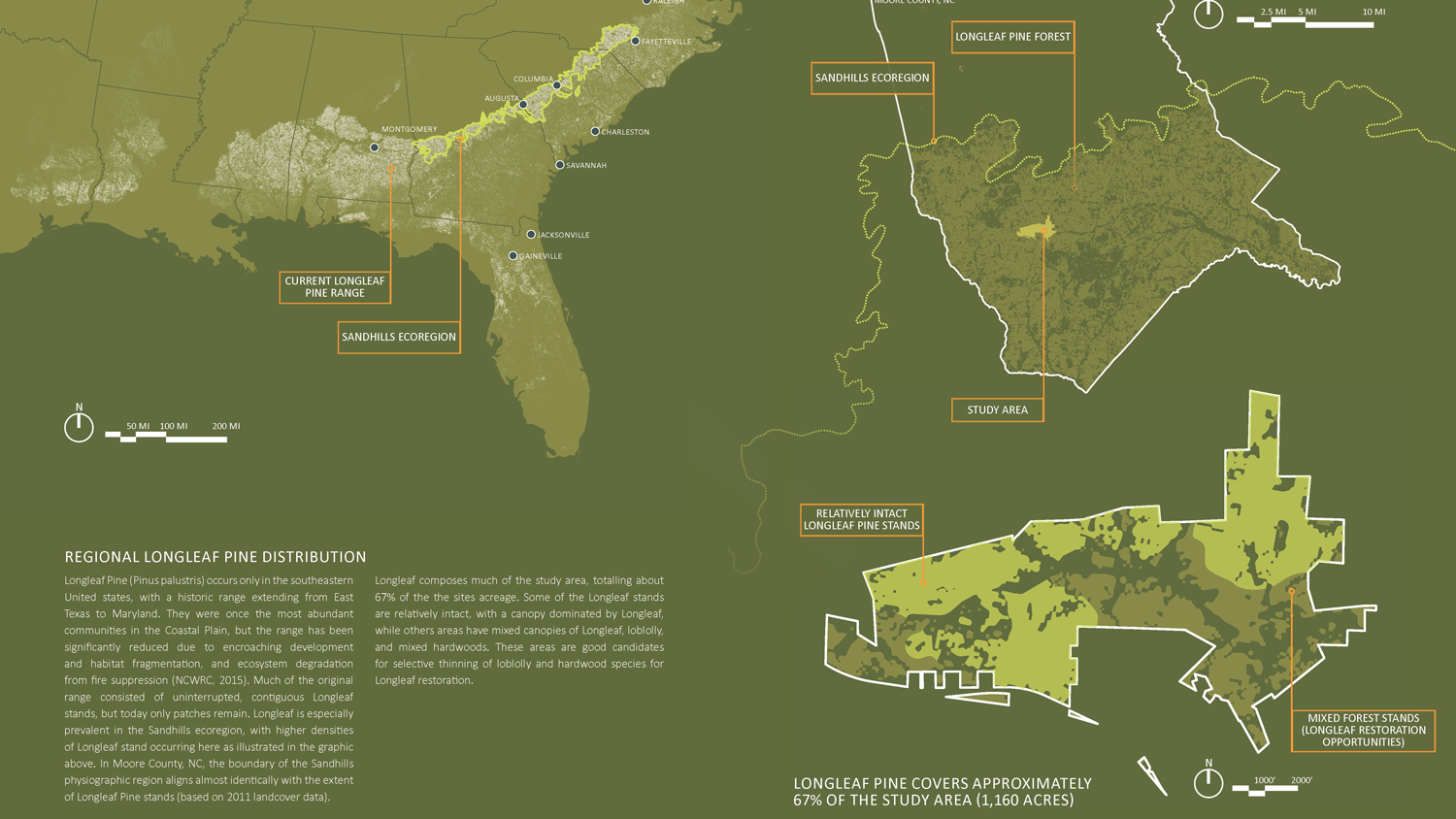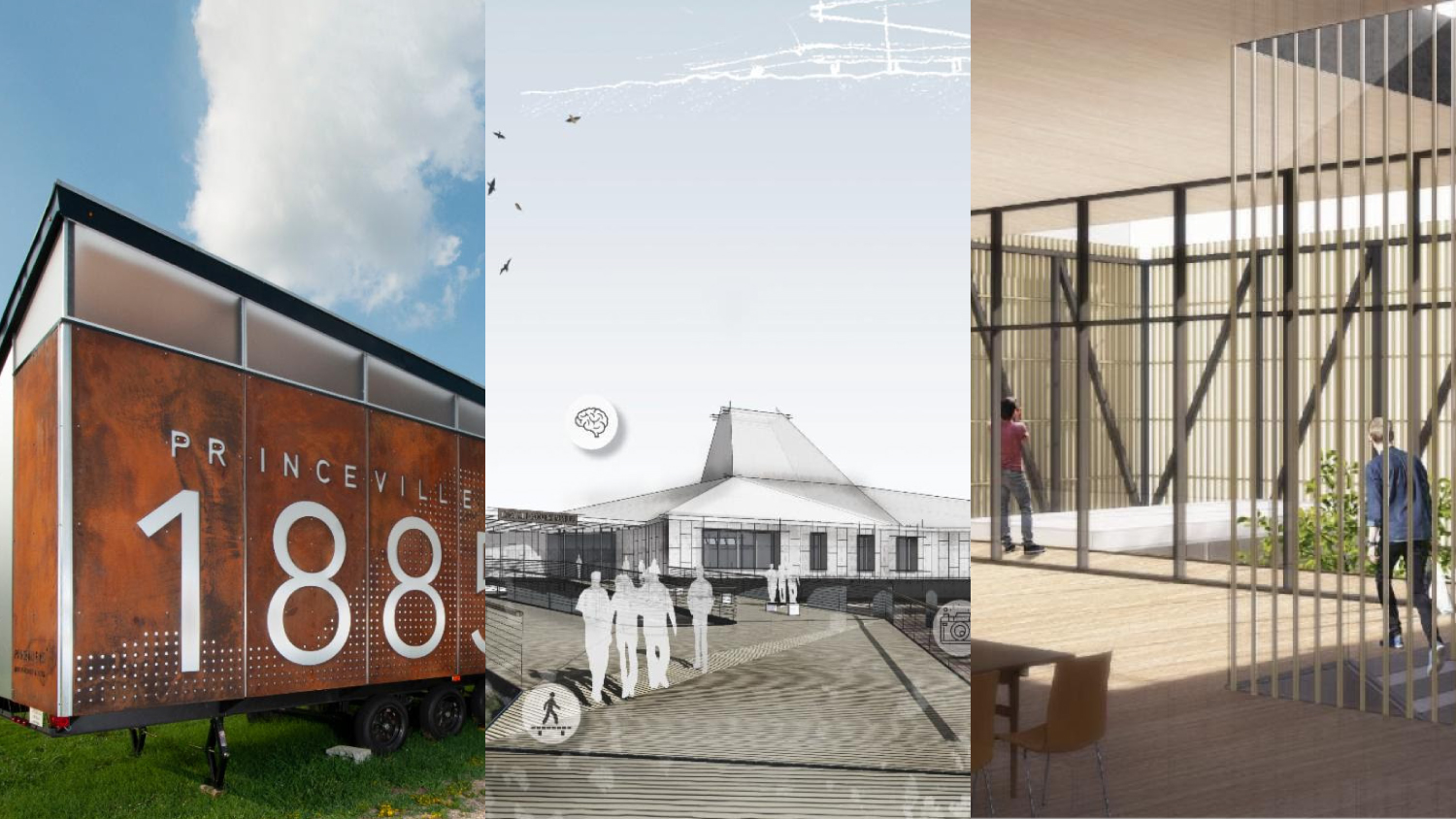The 13th Annual Graduate Student Research Symposium
The Symposium is organized by the Graduate School and additional support by the Graduate Student Association and held each March. The event includes more than 200 graduate students from across the University. Each poster submission is judged by a team of faculty and showcases outstanding quality and diversity of graduate research.
EVENT DATE: March 21, 2018 | LOCATION: McKimmon Center
The College of Design had thirteen students participate and the top three selected are:
1st Place: Katie McCracken
2nd Place: Josh Wall
3rd Place: Rachael Paine
Below is a Listing of all College of Design student abstracts:
Kirsten E. Benson | Graduate Program: Design | Advisor: Tania Allen
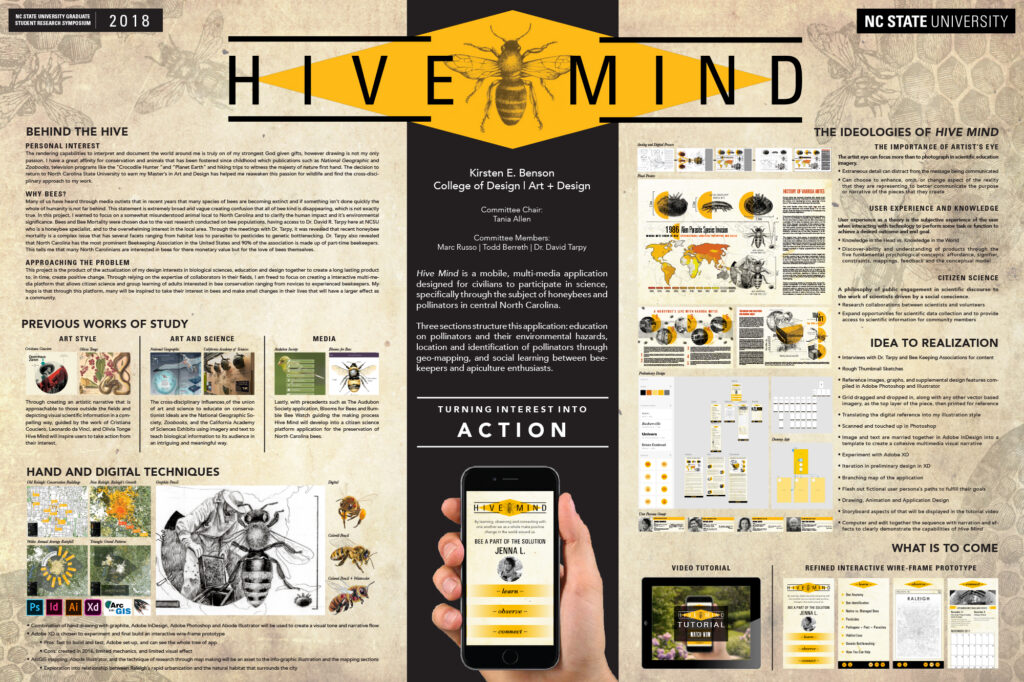 Hive Mind: Mobile Application to Inspire Action for Local Pollinators
Hive Mind: Mobile Application to Inspire Action for Local Pollinators
Recent and prolific news reports on the unstable mortality rates of bee populations have emphasized their critical importance to agriculture and the survival of the human community as a whole. Most still do not understand how exactly, bees are impacted by the effects human behavior, and environmental hazards have on their populations. Additionally, North Carolina has the most extensive beekeeping association in the United States, but unlike other states, 90% of the organization is made up of part-time or hobbyist beekeepers, which provides an ample community of honeybee and pollinator enthusiast to inspire to affect significant change in North Carolina. Hive Mind is a mobile, multi-media application, which provided the platform for civilians to participate in science, precisely through the subject of honeybees and pollinators in central North Carolina. Three sections structure this application: education on pollinators and their environmental hazards through illustrated informational graphics; location and identification of pollinators through geo-mapping creating a platform for civilian science; and social learning between beekeepers and apiculture enthusiasts in a social platform. The goal of this project is to capitalize on this interest and awareness in honeybees and native bees and inspire action in the users. These aspects are being developed through design research and experimentation and working in collaboration with expert entomologist Dr. David R. Tarpy. The deliverable of this study will be an interactive wireframe prototype of Hive Mind on a tablet and written thesis of tools and techniques, influences, theoretical framework and cross-disciplinary conversations with the entomology and design.
Clément Bordas | Graduate Program: Graphic Design | Advisors: Helen Armstrong, Denise Gonzales Crisp, and Matthew Peterson
 Collaborating with Machines Rather than Commanding Them: Interaction and Interface Design for a Human-AI Collaboration Paradigm
Collaborating with Machines Rather than Commanding Them: Interaction and Interface Design for a Human-AI Collaboration Paradigm
Machine learning is changing the way designers interact with computers. Machines are now able to generate predictions from billions of data points without the need to be programmed. Machine learning allows computers to be trained to act as intelligent agents. This new technology opens up possibilities for reinventing user interface using interaction design principles adapted to machine learning and collaborative techniques. This research investigates the design of interfaces that utilize machine learning to help designers address increasingly complex contemporary design problems. A framework, which integrates several Human-Computer Collaboration (HCC) approaches with machine learning, will underpin the design of these interfaces. This framework will consider computers as intelligent partners in a joint human-computer paradigm. In this paradigm, the human and the computer will collaborate and contribute to achieve shared goals while considering the strengths and weaknesses of both partners. My research methods will be based around this adapted HCC framework, mapping out a range of issues and themes using scenarios, user journey maps, and storyboards, as well as the generation of visual studies and rapid prototypes. Focusing this research specifically on the impact of machine learning upon collaborative activity, via an interface, brings to the forefront of this investigation the impact of big data upon the design process. To propose meaningful, inclusive design solutions, designers must be able to access and analyze expert data and knowledge. Machine learning techniques can enable designers to access this data and knowledge in real time and thus influence their design decisions. Ultimately, this research presents opportunities for designers to define a new collaborative human-computer relationship enabled by machine learning.
Jingyuan Fu | Graduate Program: Design | Advisor: Art Rice
Design Based Study Abroad: The Critical Step in Fostering Creative Designers
The research reported on in this poster demonstrates that design study abroad experiences may be one of the most impactful elements of a design education with regard to enhancing an individual’s creative potential. This research builds on a number of recent studies that have indicated that exposure to other cultures can enhance some aspects of creativity. Specific aspects of creative ability were studied and measured in undergraduate design students over a period of three years. Some students, who did not participate in study abroad, pursued their design studies during a semester at a major design college in the United States. Other students in the design college, with similar backgrounds, elected to spend a semester attending a design study abroad experience. Data collected included the results of a series of validated tests used to evaluate aspects of divergent thinking, convergent thinking, and personality related to creativity. A comparison of baseline pre-experience scores of the treatment group and the control group revealed no significant difference prior to the study abroad experience. When the results of a series of validated tests given before and after the study abroad semester were analyzed, those students participating in study abroad showed significant improvement in all of the creativity measures. Those design students electing not to participate in the study abroad semester over the same period of time showed no improvement in three of the creativity measures and a decline in creativity in one. This poster presents details of the study methodology, measurement tests, and statistical analysis of findings. In addition, the results of a parallel study abroad student journaling exercise are discussed that begin to reveal the most impactful elements of a design study abroad experience.
Mac Hill | Graduate Program: Graphic Design | Advisor: Matthew Peterson
 Developing an Experiential Visual Language for Uncertainty in Data Journalism
Developing an Experiential Visual Language for Uncertainty in Data Journalism
Data journalism has become a pervasive feature of mass media, with infographics and visualizations appearing in print, online, and in television coverage. While visualizations in mass media can render data accessible to the public, they can also give viewers a false sense of truth and certainty. Uncertainty, meaning incomplete or imperfect data, exists in all information and visualizations; it can be introduced during collection, analysis, or even visualization, but it is often left out of final information visualizations. Conveying the uncertainty involved in a data set provides viewers with a fuller picture and more robust understanding of an issue. Currently, there is not a robust, perceptually-sound visual language for conveying that uncertainty. While there are methods for visualizing uncertainty in scientific or statistical figures, those graphics are typically created for audience’s familiar with the visual language of scientific data, making them inaccessible to non-expert audiences. This provides an opportunity for graphic design methods and research to expand those techniques to non-expert audiences. Drawing from graphic design methods and frameworks, in addition to statistical and scientific methods for conveying uncertainty, this study explores experiential techniques that data journalists can use to convey uncertainty in statistical and scientific information to a non-expert audience.
Amber Ingram | Graduate Program: Graphic Design | Advisor: Helen Armstrong
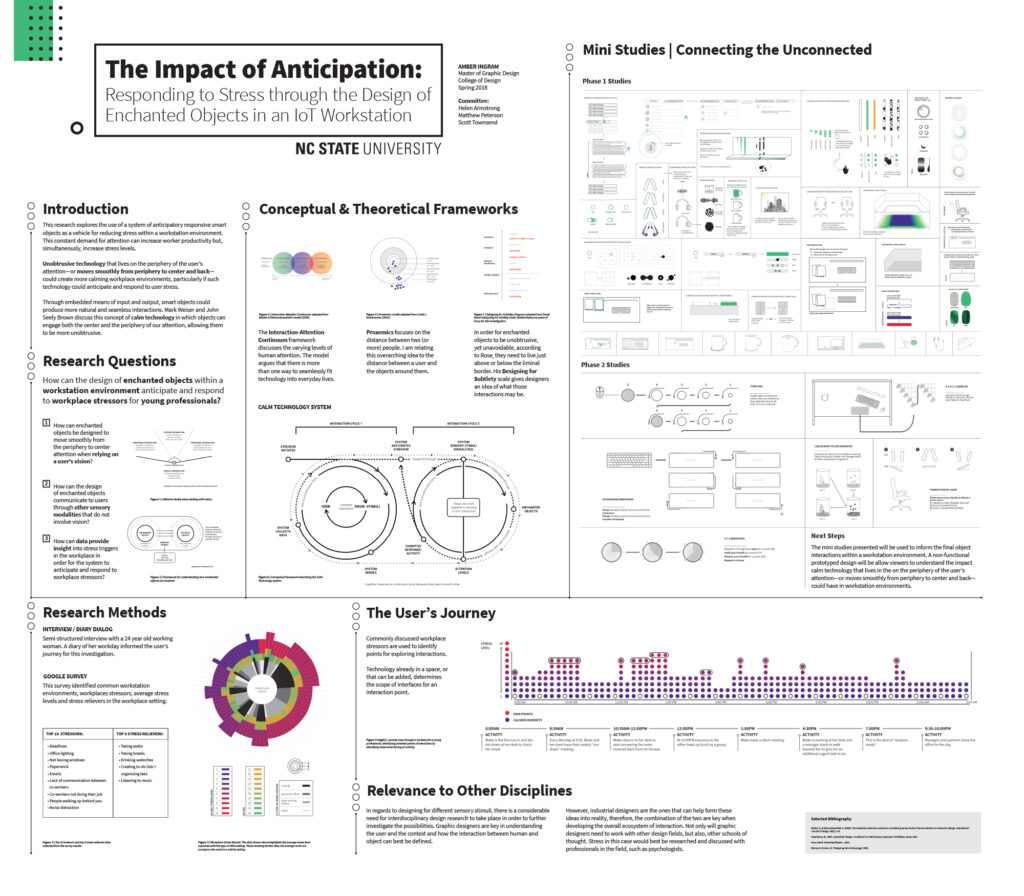 The Impact of Anticipation: Responding to Stress through the Design of Enchanted Objects in an IoT Workstation
The Impact of Anticipation: Responding to Stress through the Design of Enchanted Objects in an IoT Workstation
This research explores the use of a system of anticipatory responsive smart objects as a vehicle for reducing stress within a workstation environment. Contemporary connected workplace technology often demands a user’s undivided attention, pushing the user from one task to the next via notifications, alerts, buzzes, beeps, and alarms. This constant demand for attention can increase worker productivity but, simultaneously, increase stress levels. Unobtrusive technology that lives on the periphery of the user’s attention—or moves smoothly from periphery to center and back—could create more calming workplace environments, particularly if such technology could anticipate and respond to user stress. Through embedded means of input and output, smart objects could produce more natural and seamless interactions. Mark Weiser and John Seely Brown discuss this concept of calm technology in which objects can engage both the center and the periphery of our attention, allowing them to be more unobtrusive. Other researchers agree and have created their own frameworks for understanding user attention levels. In this investigation, focused, peripheral and implicit interactions will be considered through the lens of David Rose’s Designing for Subtlety scale, which defines ways that smart objects can communicate with users. As Rose suggests and Michael Haverkamp, synesthetic research engineer, describes, different bodily senses (modalities) can engage with input to produce peripheral and implicit interactions via connected devices. The intent of this study is to identify opportunities for such ambient, anticipatory design interventions to redefine the workstation user experience, in an attempt to lower stress via a more thoughtful engagement with human attention levels.
Jasmine Kent | Graduate Program: Industrial Design | Advisor: Sharon Joines
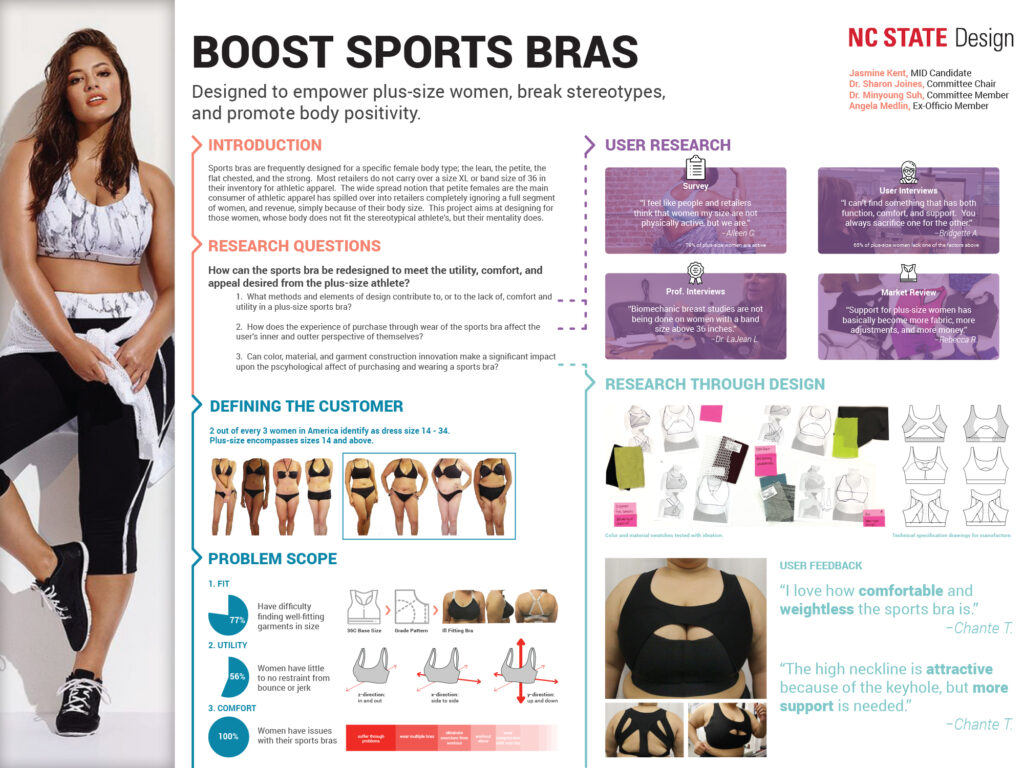 Plus-Size Sports Bra Design: A human-centered design approach to influence and empower by design
Plus-Size Sports Bra Design: A human-centered design approach to influence and empower by design
Sports bras were the necessary coupling to Title IX that enabled women to participate in sports to their fullest potential. Today, more than 3.2 million girls are playing sports in high school and over 193,000 women are playing sports at the NCAA level. Even more girls and women are active outsides of sports with the rise in boutique exercise classes like pole fitness, barre, pilates, and more. However, non-inclusive body image has plagued women based on what the female athletic body should look like. It has caused women that do not think they have a small enough frame, bust size, muscle tone, or height to believe that they cannot participate in sports or any type of activity. Clothing retailers have exacerbated this problem by not providing sports bra options for plus-size women or providing lesser quality options for them. This research investigates the plus-size body, the process of designing garments for it, and the shortcomings of the existing products. A human-centered design research methodology was utilized where primary research was done by interviewing the biomechanical, technical, and design team at Hanes. A survey was conducted with 287 plus-size women, dress size 16+, to attain their opinions on sports bra design for their bodies. A fit model was obtained from the survey participant pool and will be used to create three prototypes to be critiqued through focus groups of plus-size users and expert reviewers. Findings to date have shown that utility, fit/comfort, and appeal are the main categories that are not provided to the plus-size market through sports bras. The new sports bra must provide full coverage of breasts during activity, eliminate distracting elements, and soften bounce during rhythmic activity.
Charity G. Kirk | Graduate Program: Industrial Design | Advisor: Kelly Umstead
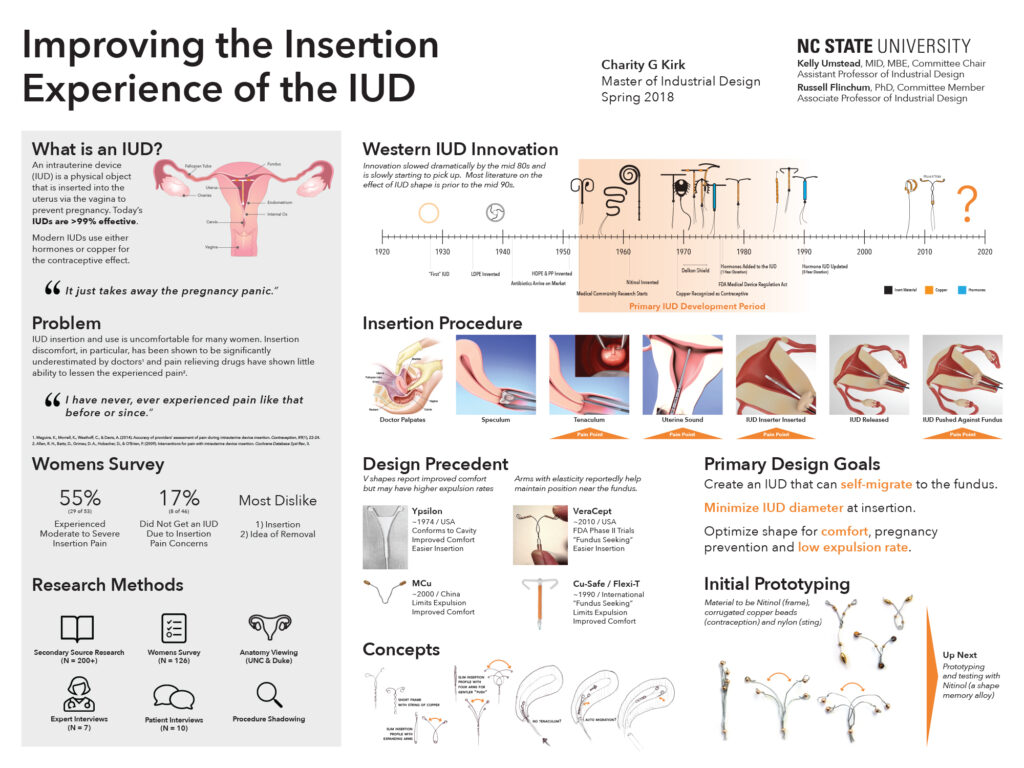 Improving the IUD Insertion Experience in Nulliparous Women
Improving the IUD Insertion Experience in Nulliparous Women
IUD (intrauterine device) insertion and use is uncomfortable for many women. Nulliparous women report greater discomfort, likely due to having a smaller uterus and a tighter internal orifices of the cervix. Insertion discomfort, in particular, has been shown to be signifiantly underestimated by doctors and pain relieving drugs have shown little ability to lessen the experienced pain. The IUD has seen little research and development since the 1980s and almost no research since then has centered on improving the insertion experience (beyond drug studies). As suggested in the literature, reducing insertion pain might increase acceptance and uptake of the device. Additionally, reducing the pain experienced at insertion may improve a woman’s overall experience. This investigative study proposes an IUD design aimed at improving the experience of both the doctor and patient during the insertion procedure. Design criteria were compiled and crafted from multiple qualitative and quantitative methods: an extensive secondary source review, patient surveys, interviews, insertion observations, and anatomical studies. Based on these criteria, prototypes for an improved IUD and insertion device have been tested on uterine models and are presented here.
Hongyang Liu | Graduate Program: Design | Advisor: Sharon Joines
Interaction Design of New Technologies for Older Adults: From the Ease of Learning Perspective
Technology as a concept can generally be defined as any electronic or digital product (tablet, mobile phone, laptop, TVs, digital camera, headphones, etc.) or service (e.g., banking apps, browsers, online shopping, etc.). Although these technologies can benefit older adults (i.e., 65 years of age or older) through their everyday activities, older adults have more difficulty than younger individuals in using and learning to use new technology. The learning process among older adults is one of the important factors when considering how to improve the ‘learnability’ of new technology. Moreover, people with different levels of technology expertise have different user experiences. With higher levels of technology expertise, people are expected to have a better understanding of new technologies and more efficient learning processes. Hence it is essential to investigate older adults with different levels of expertise and to look into the differences in learning processes between these groups. This study aims to explore the interaction design factors of new technologies that can influence the learning process for older adults. As the target of this research, older adults with 4 different levels of technology expertise (novice users, advanced beginners, competent users, and proficient users) were recruited. 8 focus groups (37 participants) were conducted to investigate the barriers of interactions with new technologies, the learning method preferences, and the learning tools between groups of older adults with different levels of expertise. Thematic coding analysis was used to generate findings and insights. The resulting findings and insights will be applied to prototyping and design recommendation development in future studies.
[1st Place] Katherine McCracken | Graduate Program: Industrial Design | Advisors: Sharon Joines and Bryan Laffitte
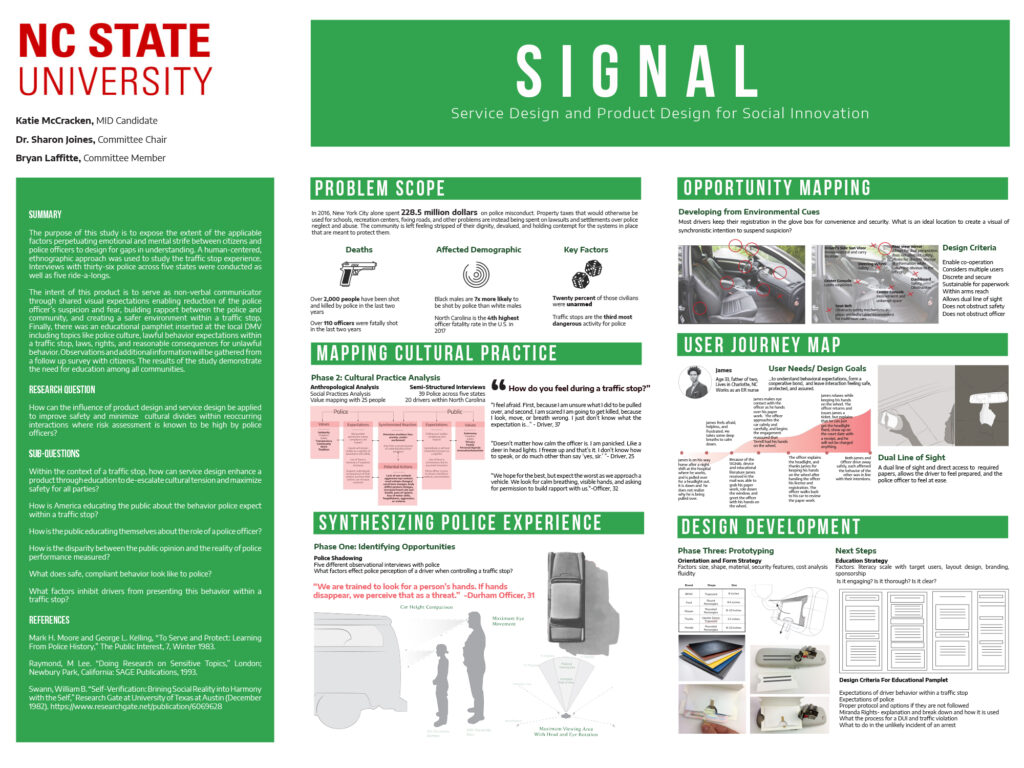 Community Connection Through Social Innovation
Community Connection Through Social Innovation
Over 2,000 people have been shot and killed by the police in the last two years, and twenty percent of people shot are unarmed. Young black men are eighty percent more likely to be shot by police than any other demographic and are most likely to be shot during incidents that begin with routine traffic or pedestrian stops. Traffic stops are the third most fatal activity for police officers. The combination of edgy officers and anxious drivers means that traffic stops are often one miscalculation away from tragedy, regardless of the driver’s race. The purpose of this study is to expose the extent of the applicable factors perpetuating emotional and mental strife between citizens and police officers and design for gaps in understanding. A human-centered, ethnographic approach was used to study the traffic stop experience. Interviews with thirty-six police across five states were conducted as well as five ride-a-longs. Through collaborative mapping of the police officer’s and the citizen’s experience combined with overlapping assumptions gaps in understanding were revealed. Within the second part of the study, a car accessory prototype is introduced and reviewed by police for evaluation of protocols and assessing design short-comings due to lack of exposure or cultural understanding. The intent of this product is to serve as non-verbal communicator through shared visual expectations enabling reduction of the police officer’s suspicion and fear, building rapport between the police and community, and creating a safer environment for necessary actions. Finally, there was an educational pamphlet inserted at the local DMV including topics like police culture, lawful behavior expectations within a traffic stop, laws, rights, and reasonable consequences for unlawful behavior. Observations and additional information was gathered from a follow-up survey with citizens. The results of the study demonstrate the need for education among all communities.
Lesley-Ann Noel | Graduate Program: Design | Advisors: Tsailu Liu and Traci Rider
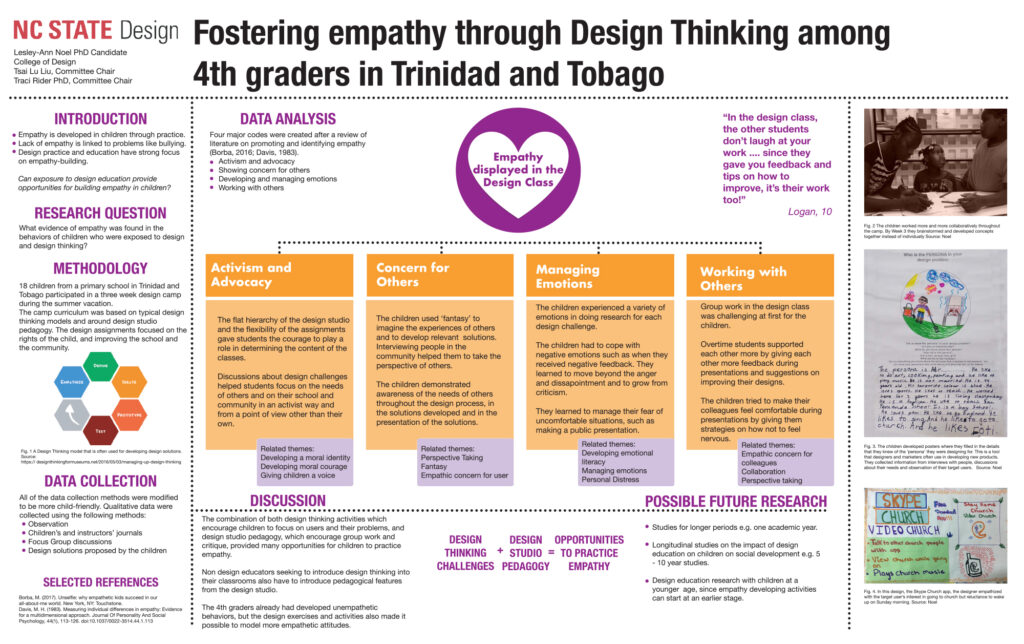 Fostering empathy through Design Thinking among 4th graders in Trinidad & Tobago
Fostering empathy through Design Thinking among 4th graders in Trinidad & Tobago
Empathy is a skill that must be developed in children, and lack of empathy has been linked to problems such as bullying at school. Empathy is also a skill that is needed later on in life that can lead to greater success in professions such as healthcare, customer service, sales and marketing and education. Designers use empathy to better understand the lives of the people for whom they design. Therefore, design education at primary school could provide a learning experience that facilitates the development of empathy. In this qualitative study, children from a 4th-grade class at a primary school in Trinidad and Tobago participated in a three-week summer camp with a curriculum based on design thinking. One of the aims of the study was to examine how children practiced empathy during the design class. Data were collected via focus group discussions, observations and journal reflections by the children and the instructors and analyzed. Findings revealed that children practiced empathy at several stages in the design process such as in defining the design problem, in doing research with target stakeholders and in developing appropriate solutions. The findings also demonstrated that the pedagogical style of the design class and collaborative nature of the design studio, where children work very closely with their colleagues also meant that children could practice empathy in group collaborations and during the critique as they listened to the presentations of their colleagues and gave feedback on the projects. These findings improve our knowledge of the potential benefits of design education at primary school demonstrating how design education can be used to enhance the social development of children by providing opportunities for them to practice empathy.
[3rd Place] Rachael L. Paine | Graduate Program: Graphic Design | Advisor: Deborah K. Littlejohn
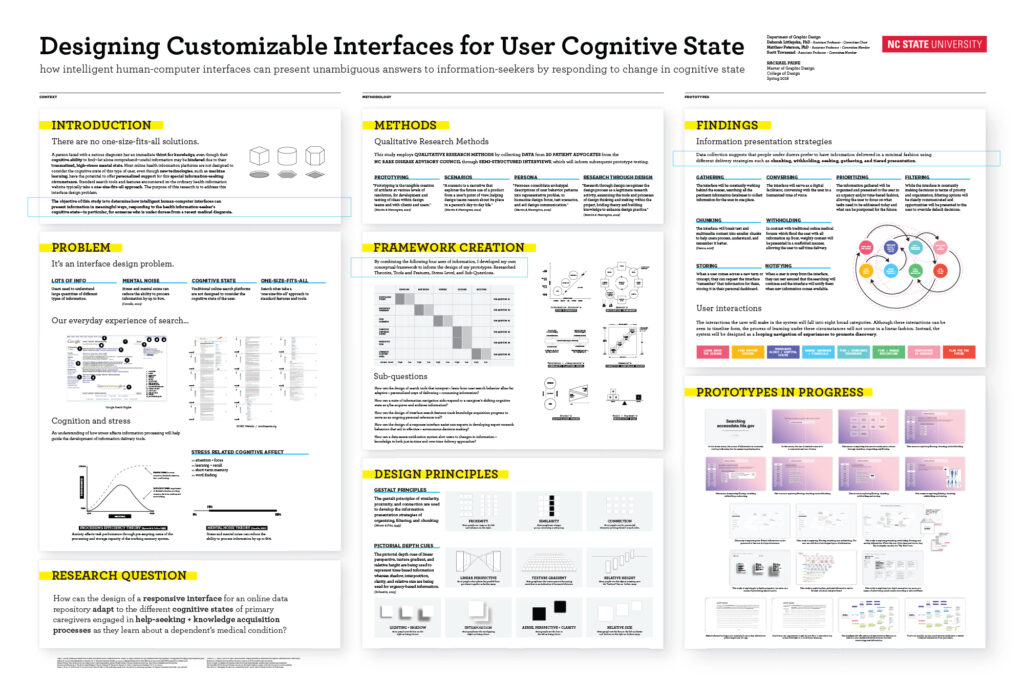 Customizable Interfaces for Varying User Cognitive States
Customizable Interfaces for Varying User Cognitive States
According to a 2014 Pew Research Internet Project study, 72% of internet users searched online for health information within the past year. A person faced with a serious diagnosis has an immediate thirst for knowledge, even though their cognitive ability to find—let alone comprehend—useful information may be hindered due to their traumatized, high-stress mental state. Research on learning and cognition has shown that stress and mental noise can reduce a person’s ability to process information by up to 80% [Covello, 2002]. Most online health information platforms are not designed to consider the cognitive state of this type of user, even though new technologies, such as machine learning, have the potential to offer personalized support for this special information-seeking circumstance. Standard search tools and features encountered on the ordinary health information website typically take a one-size-fits-all approach. The purpose of this research is to address this interface design problem. The objective of this study is to determine how intelligent human-computer interfaces can present information in meaningful ways, responding to the health information-seeker’s cognitive state—in particular, for someone who is under duress from a recent medical diagnosis. This study employs participatory research methods by collecting qualitative data from 20 patient advocates from the Rare Disease Council through semi-structured interviews, which will inform subsequent prototype testing. Data collection suggests that people under duress prefer to have information delivered in a minimal fashion using different delivery strategies such as chunking, withholding, seeking, gathering, and tiered presentation. This project is a small part of a long-term study. The ultimate goal is to create a semi-working proof of concept / prototype that responds to, or is customizable to, a user’s cognitive state.
Jinoh Park | Graduate Program: Design | Advisor: Traci Rose Rider
 Conceptualizing a Wellness Program Facilitated through the Built Environment: Facilitating the WELL Building Standard through Wellness Programs in the Workplace
Conceptualizing a Wellness Program Facilitated through the Built Environment: Facilitating the WELL Building Standard through Wellness Programs in the Workplace
As the public interest in health and well-being has increased and researchers have found a correlation between health and productivity of employees, various governmental, corporate, and organizational services have been developed and released to support increasing employees’ health outcomes. The U.S. government established regulations to release wellness programs. However, the wellness program, as part of the governmental and corporate services, does not satisfy the expectation of employee and employer because of (1) the increase of healthcare service costs, (2) the limited eligible participants and options of programs, and (3) the absence of an integrated program approach rather than independent program approaches. To improve wellness programs with existing resources and efforts, this research suggests that the built environment is a medium which can reduce the burden of healthcare cost, expand the range of program participants, and connect independent services. This study explores theoretically structuring a connection between wellness programs and the built environment based on the WELL Building Standard, aiming to identify affordable criteria of WELL which can support wellness programs. First, this study outlines the process of building a wellness program through both the program categories under regulations and actual programs by operators. Second, existing wellness programs are broken down according to the respective categories and programs in the outlined structure. Third, the categorical concepts and criteria of WELL Building Standard are arranged according to the respective elements in the outlined structure. Then, overlaps in subdivided wellness programs and WELL Building Standard are illustrated and applicable criteria of the WELL Building Standard are compared to elements of wellness programs identified in the established structure. Finally, this paper suggests the incorporation of WELL Building Standard as part of wellness programs by changing the paradigm of built environment from an environmental context to an active contributor in a wellness program.
[2nd Place] Joshua Wall | Graduate Program: Industrial Design | Advisor: Sharon Joines
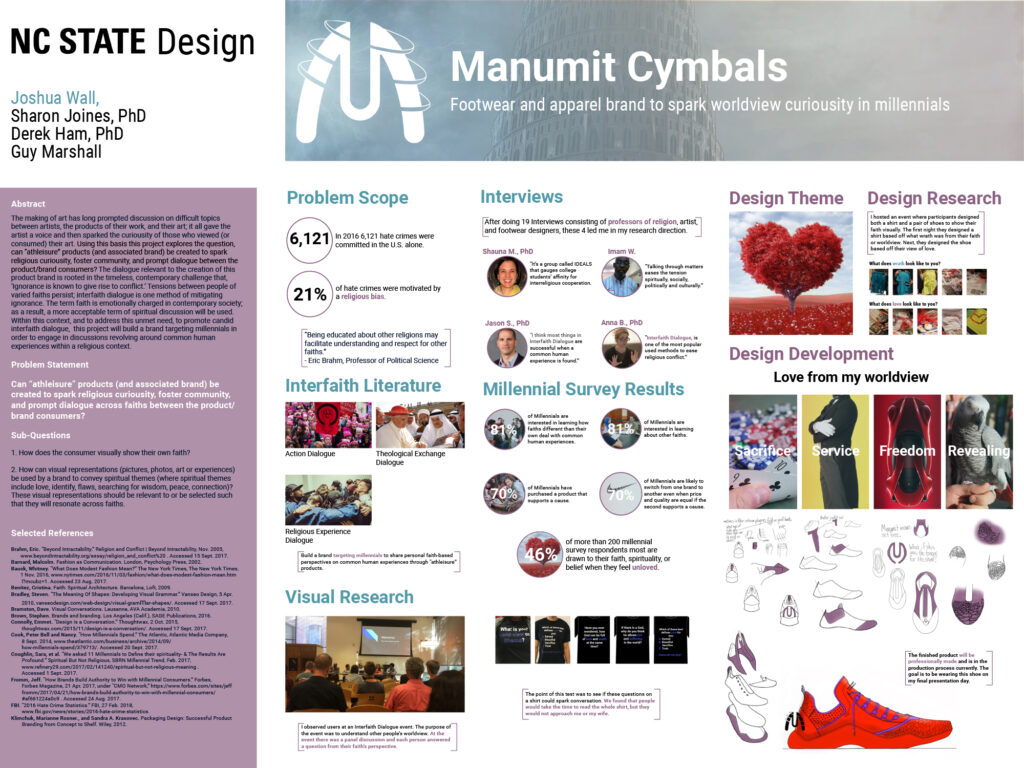 Manumit Cymbals | Can “Athleisure” product (and associated brand) lead to discussion across faiths?
Manumit Cymbals | Can “Athleisure” product (and associated brand) lead to discussion across faiths?
The making of art has long prompted discussion on difficult topics between artists, the products of their work, and their art; it all gave the artist a voice and then spoke to those who viewed (or consumed) their art. Using this basis, can “athleisure” product (and associated brand) be created such that it provides a voice to those who create it (the designer) and ultimately foster community and prompt dialogue between the product/brand consumers? The dialogue relevant to the creation of this product brand is rooted in the timeless, contemporary challenge that, ‘Ignorance is known to give rise to conflict.’ Tensions between people of varied faiths persist an interfaith dialogue is one method of mitigating ignorance. The term faith is emotionally charged in contemporary society; as a result, a more acceptable term of spiritual discussion will be used. Within this context, and to address this unmet need, to promote candid interfaith dialogue, this project will build a brand targeting millennials in order to engage in discussions revolving around common human experiences within a religious context.
For a listing of all 200+ graduate abstracts, click HERE
For a listing of 2018 winners by college unit, click HERE
- Categories:
